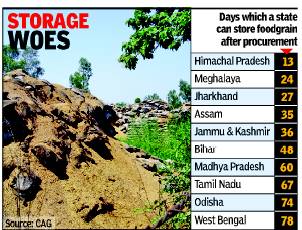Foodgrains and their management: India
Oxford Dictionaries allow spelling foodgrain as a single word. Most others, including Merriam-Webster and Collins English Dictionary spell it as two words, food grain.
This is a collection of newspaper articles selected for the excellence of their content. |
Contents |
The states’ capacity to store foodgrains after procurement
Pradeep Thakur TNN 2013/06/16
Most states can’t stock grains beyond 75 days
New Delhi: A CAG report on foodgrain management in the country paints a grim picture on the states’ capability to manage operational stock of foodgrain. Out of 31 states and Union territories, eight have storage capacities of 120 days.
Most poor states such as Bihar, Jharkhand, Madhya Pradesh, Odisha, West Bengal, Tamil Nadu and Assam do not have the capacity to handle stocks for more than 13-75 days. HP, Meghalaya, J&K, Jharkhand and Assam cannot even handle their stock for a month. Audit reveals that more than 1 lakh tonne of wheat worth Rs 122 crore was damaged in Punjab and Haryana alone in the last two years.
Despite the fact that over a hundred lakh tonnes of foodgrain stocks as old as 2007-08 were lying in the custody of states, the government continued on a procurement drive. Also, at a time when the government’s spend on food subsidy was estimated to touch Rs 1.25 lakh crore, it exported foodgrain from its overflowing reserves at subsidized rates causing loss of over Rs 1,700 crore (in 2012-13).
Production, year-wise
2014-15: Low offtake
The Times of India, Jul 02 2015
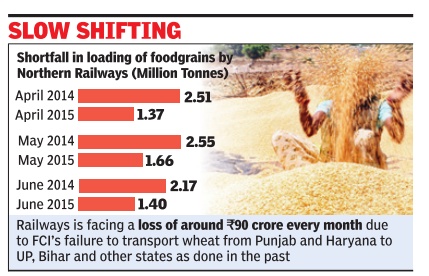
Mahendra Singh
Rlys takes `300cr hit as states cut grain buy
Reluctance of Uttar Pradesh, Bihar and West Bengal to avail subsidized foodgrains from the Food Corporation of India (FCI) has put the railways in a spot. The national transporter is suffering losses of around Rs 90 crore every month as the FCI has drastically cut down loading of foodgrains, sources said.
The substantial cut in loading target is due to the food ministry and FCI's failure to take up the issue with the these states, which have the maximum number of poor and have been the biggest receiver of subsidized foodgrains, said a top government source. He said the loading target was slashed by the FCI without prior information to the railways that led to large number of rakes lying idle.The FCI attributed it to a sudden cut in off-take of foodgrains by the states. A senior official found the food ministry and FCI's indifference to the issue intriguing. “At a time when the FCI has a stock of around 24 million tonnes of wheat procured under re laxed norms and a shorter shelf life of 8 to 10 months, the Centre and FCI must act to transport grains from Punjab and Haryana to consumer states at the earliest,“ he said. “Foodgrain loading of railways is at an all-time low and its wagon capacity is being wasted,“ said an official adding the railways has already lost around Rs 300 crore in three months.
To tame onion prices, govt extends stock limit
The Cabinet extended the stock limit on onion for one year to July 2016 in its bid to curb the rise in the commodity's prices. The validity of the order that empowers states to impose stock limits on traders for holding onion and ban hoarding beyond the set limit expires on Thursday. The decision will enable state governments take effective de-hoarding measures under the Essential Commodities Act. Oly three states Odisha, West Bengal and Telangana have so far fixed the stock limit on potatoes and onions.
2015-16: Output up despite scant rainfall
The Times of India, August 3, 2016
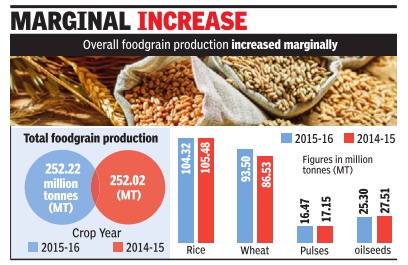
Vishwa Mohan
Foodgrain output up despite scant rainfall in 2015-16
Despite deficient rainfall and shortage of water in reservoirs, India's foodgrain production in 2015-16 is estimated to be slightly higher than the total production in 2014-15 -thanks to irrigated areas of northwest India where good wheat production more than made it up. However, pulses remain a major worry as its production reported a decline. In fact, production of most of the crops, including rice, pulses and oilseeds, is estimated to be lower in 2015-16 crop year (July-June) than their production in 2014-15.
The total production still crossed the 2014-15 figures mainly due to higher wheat production, reflecting a degree of resilience of Indian agriculture to a deficit monsoon in the areas having proper irrigation infrastructure.
The agriculture ministry came out with its fourth advance estimates of foodgrain production for 2015-16, showing that the production in the year stand at 252.22 million tonnes as compared to 252.02 million tonnes (MT) in 2014-15 that was also the drought year. Though the deficiency in Mon soon rainfall in 2015 was higher than the deficiency in 2014, the year 2015-16 managed to cross the previous year's production mark due to timely contingency measures during Rabi (winter crop) season that resulted in higher production of wheat.
The production of wheat, estimated at 93.50 MT in 2015-16, is higher by 6.97 MT than the production of 86.53 MT during 2014-15.
On the other hand, the production of pulses in 2015-16 (16.47 MT) is estimated to be slightly lower than its production in 2014-15 (17.15 MT) -a cause of concern as India has to depend heavily on import to meet its domestic demand.
Since pulses are mainly sown in rain-fed areas, decline in its production is attributed to deficit rainfall in 2015 when as many as 11states were drought-hit. Nearly all major pulse growing states such as Madhya Pradesh, Maharashtra, Rajasthan, Uttar Pradesh and Karnataka had faced severe drought.
The overall production in both the years was, however, way below the 2013-14 mark when the country had achieved a record foodgrain production of 265.04 million tonnes.
2012-17: foodgrain and oilseeds
See graphic.

2016-17, grain output-276 mn tns
2016-17 grain output at record 276 million tons, August 17, 2017: The Times of India
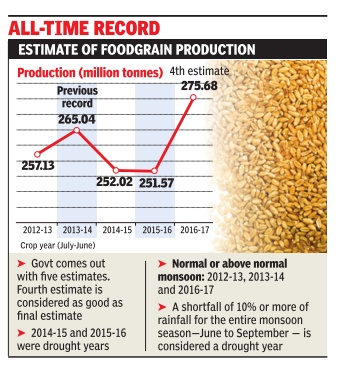
India's foodgrain production for the 2016-17 crop year is estimated at a record 275.7 million tons, a number which is expected to bring cheer to policymakers and bolster claim of efficient rollout of policies for the farm sector.
The government on Wednesday revised its previous figures upward by 2.3 million tons and the new figure is 4% higher than the previous record production achieved in 2013-14. The production in 2016-17 is significantly higher by 24.1million tons (9.59%) than the output of 2015-16 which was a drought year.
The revised figures, released on Wednesday , are part of the agriculture ministry's fourth advance estimate for the year 2016-17. In its third estimate, the ministry had put the estimated production at 273.38 million tons (MT). The ministry releases four advance estimates followed by final estimates of production of major agricultural crops every year (July-June). The fourth advance estimates are considered as good as the final estimates.
In order to provide sufficient time to states to take into account even the delayed information while finalizing area and yield estimates of various crops, the final estimates are released about six months after the fourth advance estimates.No revision in the state-level data is accepted after release of final estimates by the agriculture ministry .
India had recorded its previous best in the year 2013-14 when it produced 265.04 million tons of foodgrain, backed by good and well-distributed Monsoon rainfall.The ministry attributed the all-time record of foodgrain production in 2016-17 to good rainfall in 2016 and various policy initiatives taken by it.Record output has been achieved in all major crops of foodgrain basket like rice (110.15 MT), wheat (98.38 MT) and pulses (22.95 MT). The current crop year (2017-18) may , however, not be as good despite normal Monsoon in many parts of the country .
2017-18, grain output-277 mn tonnes

From: Foodgrain production may touch record 277 million tonnes in ’17-’18, February 28, 2018: The Times of India
Output Of Pulses & Rice Touching A New High
India’s overall foodgrain production may touch a record of 277 million tonnes in the 2017-18 crop year (July-June) with output of pulses and rice reporting a new high. The agriculture ministry released its latest estimates, just when the government has been exploring various options of procuring more and more foodgrains from farmers in the year of plenty.
Option of extending the government’s guarantee to banks and lending agencies to ensure that state agencies do not face fund crunch for procurement is likely to come up before the Union Cabinet for approval on Wednesday. The move will help states go for procurement of pulses, oilseeds and cotton under the Price Support Scheme (PSS) through central nodal agencies and the other crops by state agencies at the Minimum Support Price without worrying about paucity of funds.
The basic objectives of PSS are to provide remunerative prices to the growers with a view to encourage higher investment and production and safeguard interests of consumers by making available supplies at reasonable prices.
Though the year is expected to report decline in production of wheat and oilseeds as compared to previous year (2016-17), the latest estimates gave a new hope amid reports of good sowing of winter crops (Rabi), except wheat, in months of December-January.
The agriculture ministry, while releasing the second advance estimates of foodgrain production, attributed the record output in 2017-18 to “near normal rainfall during 2017 monsoon and various policy initiatives taken by the government”.
The ministry said that the assessment of production of different crops was “based on the feedback received from states”. It claimed that the assessment was also “validated with information available from other sources”.
The ministry releases four advance estimates, before the final one which gives details of foodgrain output.
The second estimates, released after completion of the Rabi sowing operations across the country, show that the production of wheat is likely to drop by 1% to estimated 97 MT. It is lower by 1 MT as compared to record wheat production of 98.51 MT achieved during 2016-17.
Revised figure 280MT

From: Vishwa Mohan, Record grain output for 2nd year, revised figure now 280MT, May 17, 2018: The Times of India
The government has projected a record output in its third advance estimate of the country’s foodgrain production for the crop year (July-June) 2017-18 released on Wednesday, while revising the total output figure for the year from 277.49 million tonnes (MT) in February to 279.51 MT now.
The revised estimate, which took into account production of both kharif (summer sown) and rabi (winter sown) crops, is over 4 MT more than the previous record output of 275.11 MT in 2016-17. It will make 2017-18 the second year in a row of bumper foodgrain production after the country faced two consecutive years of drought in 2014-15 and 2015-16.
Figures, released by agriculture ministry, show that most of the major crops are expected to scale new records in the current crop year.
“The production figures are quite encouraging. Record output of pulses last year had helped India reduce its import, saving Rs 9,775 crore in foreign exchange. Even export of several agricultural produce picked up during the period, backed by good output and the government’s trade policy measures,” said Union agriculture minister Radha Mohan Singh.
He told TOI that the government has been taking several steps to translate the bumper output into getting remunerative prices to farmers. “We are now focussed on income-oriented programmes rather than adopting the production-centric approach,” said Singh.
Since the India Meteorological Department (IMD) predicts normal monsoon for June-September period, the 2018-19 crop year too is expected to be good for the farm sector in terms of production.
Food grain trade depletes water sources
Why food grain trade could result in a parched earth, April 20, 2017: The Times of India
The world market for food is depleting water sources in large parts of the world quicker than they can naturally be refilled, says a study in the journal Nature. The highlights: See graphic
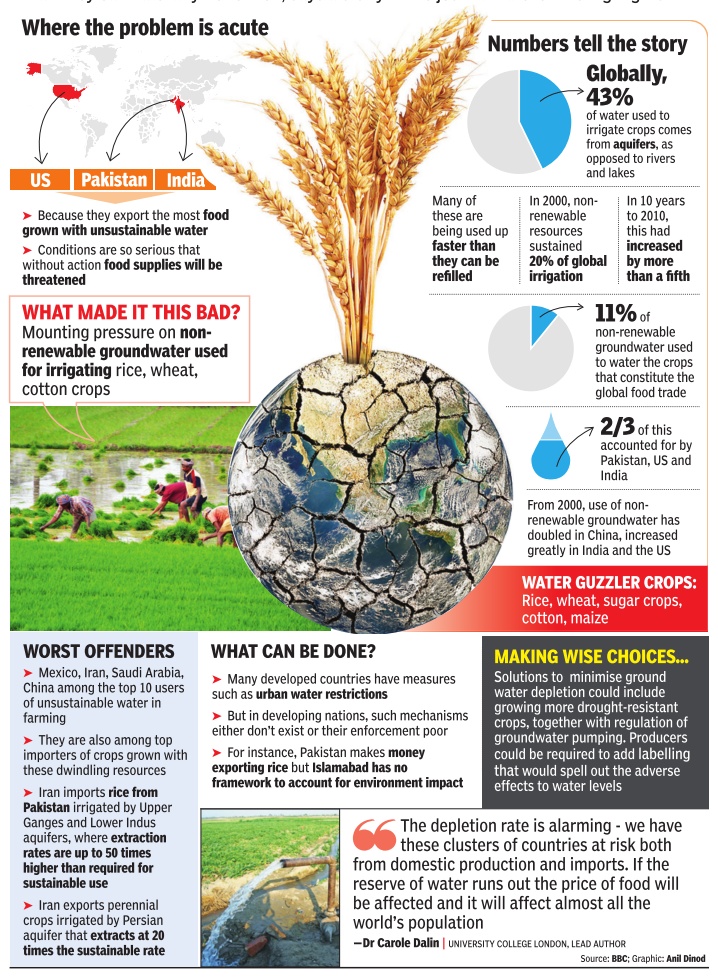
See also
Food and Civil Supplies: India <> Food and Civil Supplies, hoarding of: India <> Foodgrain management: India
